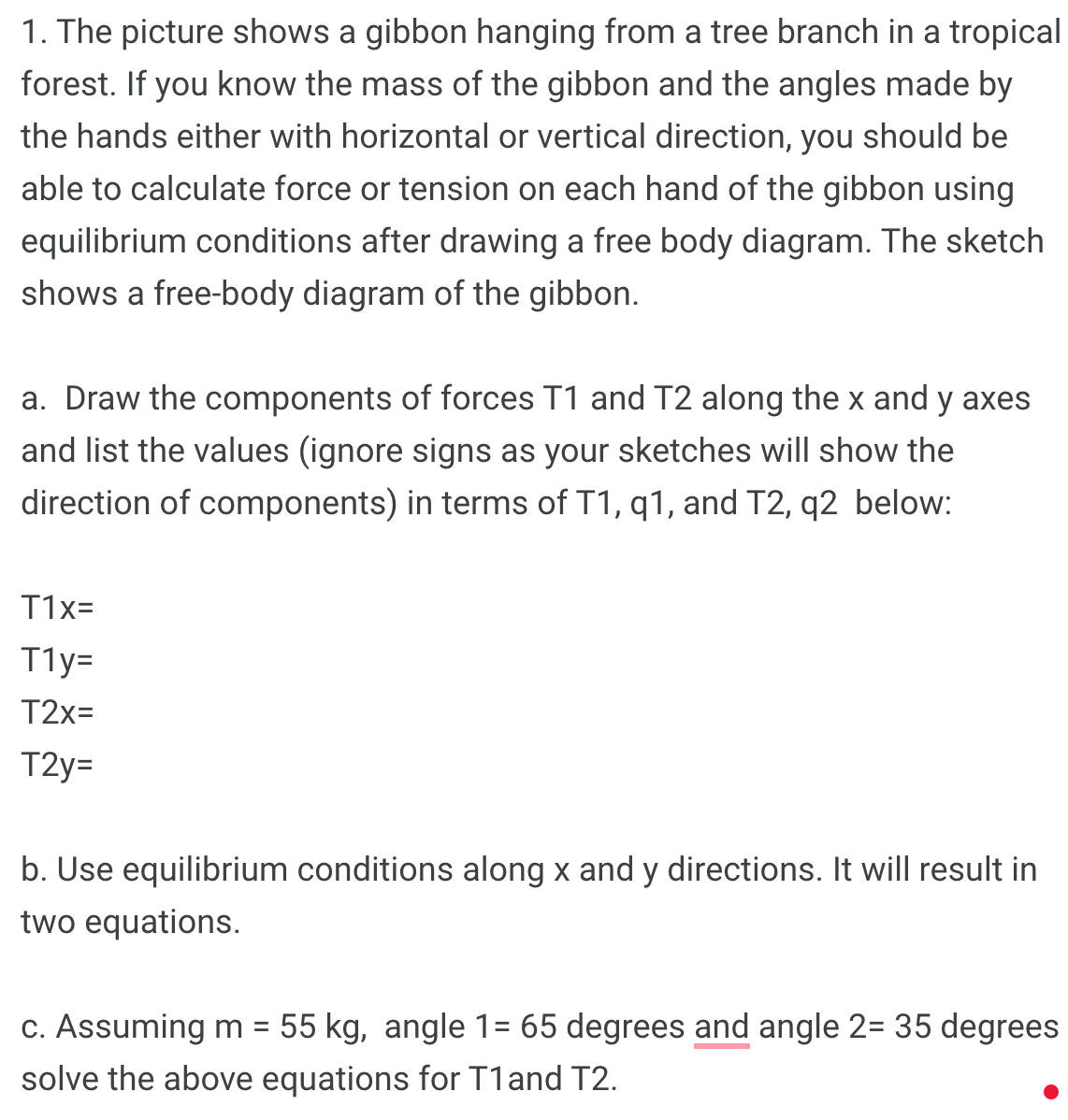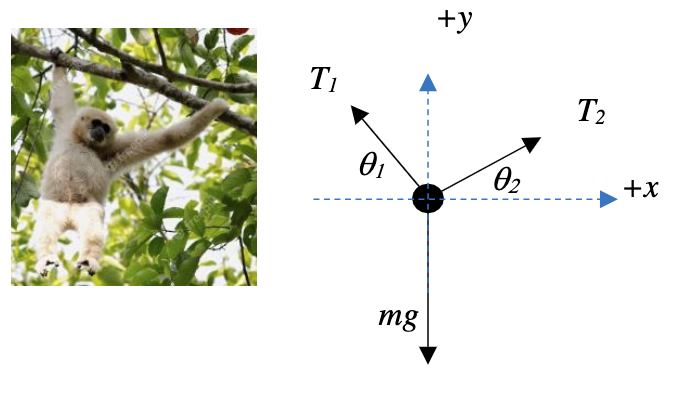a. Draw the components of forces T1 and T2 along the x and y axes and list the values (ignore signs as your sketches will show the direction of components) in terms of T1, q1, and T2, q2 below: T1x= T1y= T2x= T2y= b. Use equilibrium conditions along x and y directions. It will result in two equations. c. Assuming m = 55 kg, angle 1= 65 degrees and angle 2= 35 degrees solve the above equations for T1and T2.
a. Draw the components of forces T1 and T2 along the x and y axes and list the values (ignore signs as your sketches will show the direction of components) in terms of T1, q1, and T2, q2 below: T1x= T1y= T2x= T2y= b. Use equilibrium conditions along x and y directions. It will result in two equations. c. Assuming m = 55 kg, angle 1= 65 degrees and angle 2= 35 degrees solve the above equations for T1and T2.
College Physics
1st Edition
ISBN:9781938168000
Author:Paul Peter Urone, Roger Hinrichs
Publisher:Paul Peter Urone, Roger Hinrichs
Chapter4: Dynamics: Force And Newton's Laws Of Motion
Section: Chapter Questions
Problem 37PE: Construct Your Own Problem Consider people pushing a toboggan with four children on it up a...
Related questions
Question

Transcribed Image Text:1. The picture shows a gibbon hanging from a tree branch in a tropical
forest. If you know the mass of the gibbon and the angles made by
the hands either with horizontal or vertical direction, you should be
able to calculate force or tension on each hand of the gibbon using
equilibrium conditions after drawing a free body diagram. The sketch
shows a free-body diagram of the gibbon.
a. Draw the components of forces T1 and T2 along the x and y axes
and list the values (ignore signs as your sketches will show the
direction of components) in terms of T1, q1, and T2, q2 below:
T1x=
T1y=
T2x=
T2y=
b. Use equilibrium conditions along x and y directions. It will result in
two equations.
c. Assuming m = 55 kg, angle 1= 65 degrees and angle 2= 35 degrees
solve the above equations for T1and T2.

Transcribed Image Text:+y
T2
+x
mg
Expert Solution
This question has been solved!
Explore an expertly crafted, step-by-step solution for a thorough understanding of key concepts.
This is a popular solution!
Trending now
This is a popular solution!
Step by step
Solved in 3 steps with 3 images

Recommended textbooks for you

College Physics
Physics
ISBN:
9781938168000
Author:
Paul Peter Urone, Roger Hinrichs
Publisher:
OpenStax College

Physics for Scientists and Engineers, Technology …
Physics
ISBN:
9781305116399
Author:
Raymond A. Serway, John W. Jewett
Publisher:
Cengage Learning

College Physics
Physics
ISBN:
9781285737027
Author:
Raymond A. Serway, Chris Vuille
Publisher:
Cengage Learning

College Physics
Physics
ISBN:
9781938168000
Author:
Paul Peter Urone, Roger Hinrichs
Publisher:
OpenStax College

Physics for Scientists and Engineers, Technology …
Physics
ISBN:
9781305116399
Author:
Raymond A. Serway, John W. Jewett
Publisher:
Cengage Learning

College Physics
Physics
ISBN:
9781285737027
Author:
Raymond A. Serway, Chris Vuille
Publisher:
Cengage Learning

Glencoe Physics: Principles and Problems, Student…
Physics
ISBN:
9780078807213
Author:
Paul W. Zitzewitz
Publisher:
Glencoe/McGraw-Hill

Principles of Physics: A Calculus-Based Text
Physics
ISBN:
9781133104261
Author:
Raymond A. Serway, John W. Jewett
Publisher:
Cengage Learning

Physics for Scientists and Engineers: Foundations…
Physics
ISBN:
9781133939146
Author:
Katz, Debora M.
Publisher:
Cengage Learning